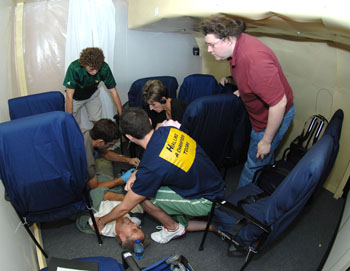
In a simulated emergency, first-year School of Medicine students attend to a fellow air traveler during a recent teambuilding exercise at Vanderbilt’s Center for Experiential Learning and Assessment. (photo by Neil Brake)
CELA gives med students feel for teamwork’s value
First-year medical students at Vanderbilt University School of Medicine had their teamwork skills and quick thinking put to the test during a day of simulated exercises at the Center for Experiential Learning and Assessment (CELA).
The 105 students interacted with standardized patients — individuals who create difficult situations for the students to navigate. During one particularly trying exercise, medical students played the role of passengers on a transcontinental flight. A medical crisis with a fellow passenger forced students to respond quickly to the situation, with little information, to make collective decisions that could mean life or death. The simulation took place inside four mock plane compartments that were constructed inside CELA.
Called Teamwork Day, the plane simulation and other educational activities were part of the two-week Foundations of the Profession course, which was added to the first-year medical curriculum last year. The course prepares students for entry into the medical profession, introducing them to core skills in a concentrated time frame.
“Research has proven that teamwork among medical professionals, across multiple disciplines, greatly improves patient safety and the overall quality of care received,” said Matthew Weinger, M.D., director of the Simulation Technologies Program at CELA. “Planting the seed that teamwork — including listening to other medical professionals, weighing all options and then agreeing on the best course of action for the patient — is our goal with these first-year students.
“Our Medical School curriculum has been greatly enhanced by the addition of CELA, and this day is a perfect example,” Weinger said. “We can create simulated, real-world scenarios in a protected environment, debrief the students immediately afterward, and have them walk away with invaluable lessons.”
The Center for Experiential Learning & Assessment training facility is on the third and fourth floors of Medical Research Building IV. The $6 million facility opened in 2007 and is home to both the Program in Human Simulation and the Simulation Technologies Program.













